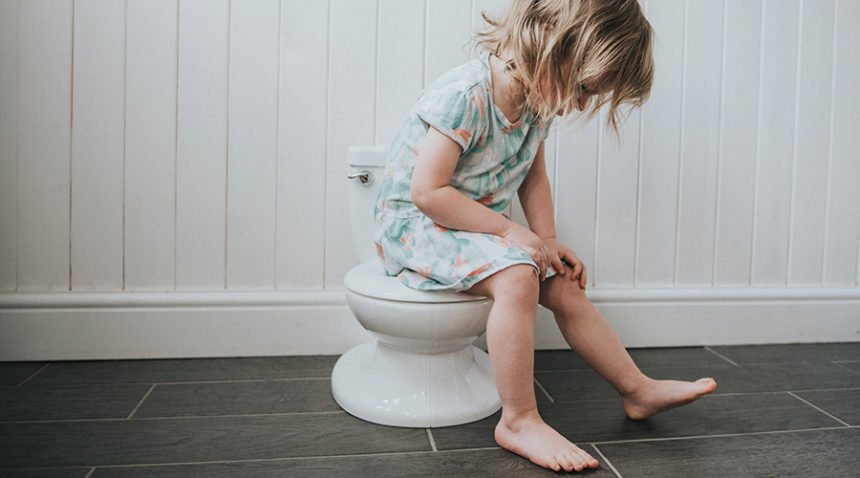A potty-trained toddler who suddenly won’t sit on the toilet.
A 7-year-old who complains of a tummy ache.
A teenager who freezes when confronted with using the bathroom at school.
All of these children might be dealing with constipation, a common problem that shouldn’t be ignored.
“Pediatric constipation is extremely common,” says Monica Shukla-Udawatta, MD, a UNC Health pediatric gastroenterologist. “Sometimes, it’s a topic kids do not feel comfortable discussing, but it is important for them and their parents to know that their pediatrician or pediatric GI physician can help them make small adjustments that can have a huge impact on their comfort.”
What Counts as Constipation in Children?
The frequency of bowel movements among children can vary considerably and still be within a healthy range for that child, Dr. Shukla-Udawatta says. Some children poop once a day or more, others every other day. Infants often poop several times a day.
Constipation is generally defined as fewer than two bowel movements in a week, one or more instances of fecal incontinence (leaking stool), or large, hard stools that are difficult or painful to pass.
Other symptoms can include abdominal pain, pain during bowel movements, decreased appetite and the feeling of being full all the time.
Constipation in children can be caused by a range of problems including the use of certain medications, poor health or a lack of proper nutrition.
How to Help if Your Child Is Constipated
1. Don’t be afraid to call the doctor.
“It’s always appropriate to reach out to your pediatrician or family doctor if your child is having infrequent or painful bowel movements,” Dr. Shukla-Udawatta says. Other reasons to call your doctor: If you have an infant with symptoms of constipation during the first year of life, if you are concerned about your child’s growth or if you see blood in their stool. Your physician will advise you to take specific actions or to come in for an office visit.
2. Befriend fiber.
Soluble fiber-rich foods act as a natural laxative by retaining water in stool and keeping stools soft, making them easier to pass. To know how much fiber your child should be eating, add 5 to their age to reach the right number of grams per day, Dr. Shukla-Udawatta says.
For example, a 3-year-old should eat about 8 grams of fiber each day. There are many ways to get there: A 1/2 cup of oatmeal has 4 grams of fiber, an apple with the skin on has 3 or 4 grams of fiber, and a medium baked sweet potato with skin has 4.5 grams.
By adolescence, children should eat 20 to 25 grams of fiber daily.
Your pediatrician may also suggest pear or prune juice to alleviate constipation in younger children. The high sugar content in these specific juices helps draw water into the colon and softens stools.
3. Talk to your child’s doctor about over-the-counter options.
There are several over-the-counter medications that treat constipation. Stool softeners or magnesium hydroxide (milk of magnesia) work by helping retain water in the stool. Medications such as bisacodyl (Dulcolax) serve as a stimulant laxative—they help to move the stool more quickly through the colon. Another option is an at-home enema.
Dr. Shukla-Udawatta emphasizes the importance of speaking with your physician before using any over-the-counter medicines, including enemas, to ensure the most age-appropriate and safe regimen.
4. Help your child feel comfortable talking to you about constipation.
Parents can learn their child is struggling with constipation in two ways: observation for younger children and conversation with older children.
For constipated children, it can help to schedule toilet time three times a day: before school, after school and after dinner. This gives children the space and time they need to relax and effectively empty their colon.
For adolescents and teens, privacy is paramount; make sure they can use the bathroom in peace and ask them to tell you if they’re struggling to go. Dr. Shukla-Udawatta recommends that families and parents directly observe after a child or adolescent uses the restroom, by asking their child not to flush the toilet after having a bowel movement. Being able to accurately describe stool appearance to your doctor is important for effective treatment.
If your child is struggling with using a public restroom at school, consider requesting a more private bathroom to use during the day. This is a reasonable accommodation to ask for on behalf of your child, and your provider’s office can help to supply the necessary letters to the school.
5. Stick with the treatment for six months.
When you are partnering with a physician to help your child’s constipation, you will need to keep up the medication, diet changes or new routine for at least six months. Ending the treatment too soon could lead to a quick reversal in progress. Sticking with it can improve your child’s daily life and establish healthy habits for the future.
Concerned about your child’s digestive health? Talk to their pediatrician. If you need a family doctor, find one near you.

